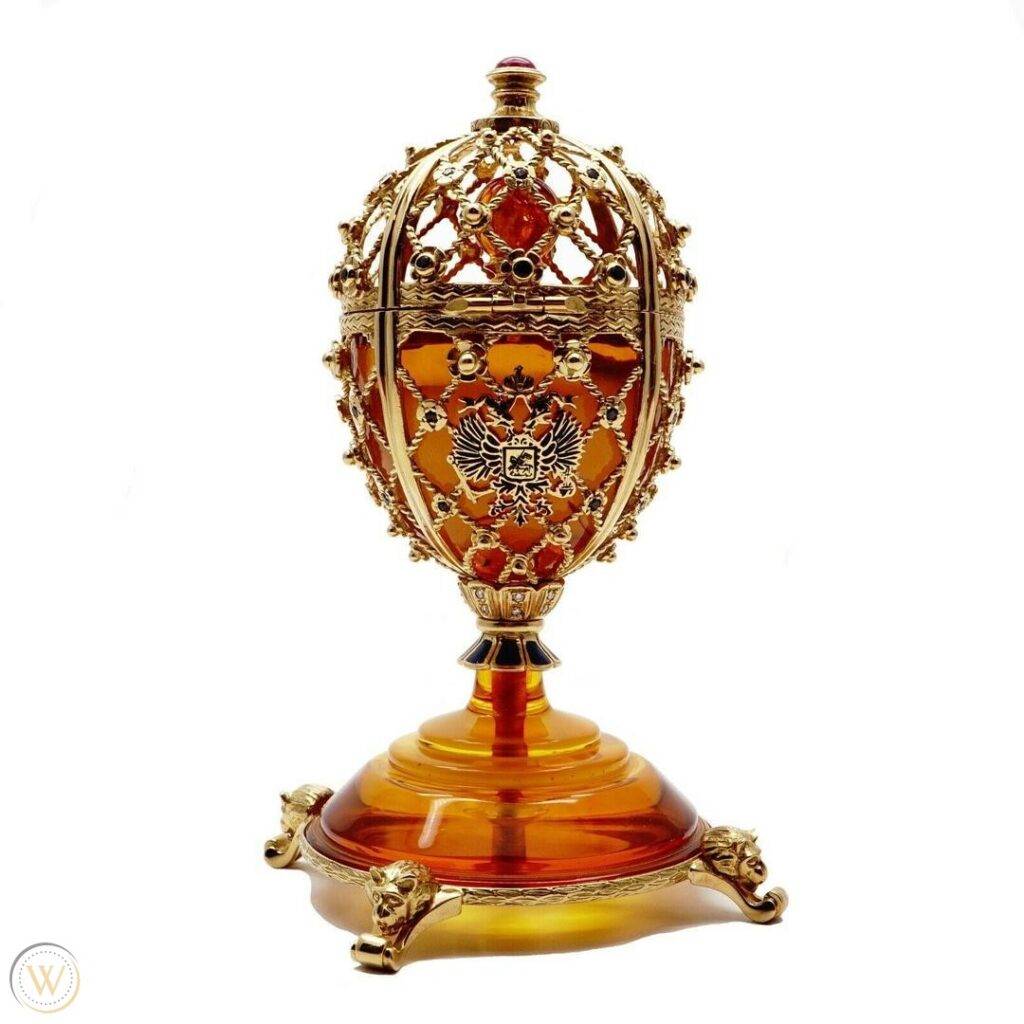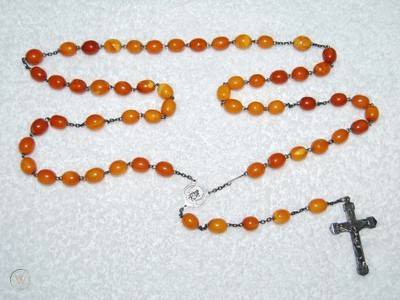Collecting Baltic Amber: Separating the Fossils from the Faux
Posted by admin on

My great aunt Sophie—known by the family as Aunt Tutz—had an eye for beautiful things. Among the trappings of her Roaring Twenties trousseau was a glamorous oriental dressing gown shot with gold thread and edged in cobalt-blue silk, along with a stunning set of eight cognac-hued, Baltic amber bangle bracelets.
Both heirlooms passed to me when I was in my teens. To my chagrin, I’ve since learned that the dressing gown was museum quality. Perhaps, had I understood its historic value back then, I would have been more cautious. I would have carefully packed it away in acid-free tissue paper. It would be handled while wearing cotton gloves to protect the delicate fabric from the corrosive damage wrought by contact with human skin.
Not knowing better, I practically lived in the wondrously flashy flapper-era garment—until I had literally loved it to death.
I suppose there are two schools of thought as far as such family treasures go: They can become a showpiece in a collection of ancestral keepsakes, or they can be your Velveteen Rabbit. In this instance, I chose “rabbit.” But somehow, I think Aunt Tutz—who adored the things that gave her pleasure and led a fairly daring, unconventional, “burn-your-candle-at-both-ends” sort of life until she married—would have approved.
Thanks to my less-than-obsessive penchant for jewelry wearing, the amber bracelets fared much better. Having survived intact, they will someday be passed to future generations.
What is Baltic Amber?
When Aunt Tutz’s bequest came into my possession, I didn’t really know all that much about Baltic amber, other than it being some kind of a fossil. However, a little homework quickly revealed that I had quite a lot to learn.
Baltic amber refers, not surprisingly, to its region of origin. During the middle Eocene Epoch some 44 million years ago, vast forests covered the Baltic shores of modern-day Russia, Lithuania, Latvia, Poland, Estonia, Denmark, Sweden, and Germany. The legacy of those countless trees has been approximated at 100,000 tons of amber. While there are deposits of amber worldwide, the Baltic amber from Kaliningrad Oblast in Russia accounts for 90 percent of the current world supply.
A Very Brief History of Baltic Amber Art & Artifacts
Examples of jewelry-grade Baltic amber artifacts predate the Roman Empire. However, the Romans truly began elevating carving the amber to a high form of art. In addition to jewelry, the Romans created various functional and decorative objects from Baltic amber.
The later craftsmen—especially those whose works were commissioned by the 18th-century courts of Russia (including famed jeweler Peter Carl Fabergé)—are best known for their works of both exquisitely detailed artistry and staggering scope in the medium.
The Amber Room, initially constructed for the Catherine Palace near Saint Petersburg, once dubbed “the Eighth Wonder of the World,” is perhaps the finest example of a large-scale Baltic amber installation. The cavernous chamber boasted walls paneled entirely in Baltic amber backed in gold leaf and accented by huge, ornate mirrors to reflect its glory.
Today, rare and precious Baltic amber antiquities grace private collections and the halls of world-renowned museums. However, collecting Baltic amber doesn’t have to break the bank. Fortunately, there are many lovely pieces to be had at various price points—from luxury to budget.

Butterscotch, Egg Yolk, Cognac… Name Your “Flavorite”
As connoisseurs of Baltic amber know, the naturally occurring wonder comes in a full menu of “flavors” that refer not to how they taste but rather to their color and degree of translucence or opacity. Cognac amber has the highest degree of translucency, while the butterscotch and egg yolk varieties exhibit the most opacity.
Fi-Fi-Faux-Fossil… Is it Baltic Amber or Bakelite?
The more I learned about Baltic amber, the more I became aware that there might be a possible fly in the ointment of my family inheritance. As it turns out, Tutz’s bangles may not be amber after all. They may, in fact, be caramel marble Bakelite (not a tragedy by any means, just a different truth).
The bracelets in question are a translucent shade of golden brown that resembles tortoiseshell. As they’re fairly lightweight, I had sometimes wondered whether or not they were perhaps made from that iconic forerunner to modern plastic. Still, the family lore maintained they were amber, so that’s what I chose to believe.
A bit of sleuthing revealed that, like Bakelite, amber doesn’t weigh all that much. That means for those well versed in the ins and outs of collecting Baltic amber, heft—or lack thereof—isn’t an immediate deal-breaker. So, my beloved baubles might yet prove to be genuine.
Further study of some how-to guides revealed several other tip-offs that separate the “to B (Baltic amber)” from the “or not to B (Bakelite).” One method is to look for what’s known as inclusions. Since amber is basically a form of fossilized tree sap, it’s likely to contain (include) anything from bubbles and tiny bugs to things as far-fetched as dinosaur feathers and carnivorous plants.

However, since such things can be replicated or—gasp!—faked by human hands, it’s best to settle the determination with slightly more scientific methods.
Unlike Bakelite, as a naturally occurring substance, amber heats to the touch. This would explain why it’s such a popular choice for prayer and worry beads. The warmth it emanates enhances the meditative experience.
In fact, apart from its intrinsic aesthetic appeal, Baltic amber has long been reputed to possess healing properties. You’ll find it used for such varied applications as necklaces to soothe teething toddlers, balms to banish acne—and even a time-honored treatment for sexual dysfunction. While some of Baltic amber’s therapeutic benefits may have a basis in folklore, recent discoveries in the field of paleopharmaceuticals have unearthed a curative potential that may hold the key to warding off some forms of drug-resistant infections.
Another way to determine the difference between Baltic Amber and Bakelite is to shine a bit of light on it—black light, to be exact. When exposed to the ultraviolet beam of a black light, Baltic amber will fluoresce—Bakelite will not.
Without immediate access to Mr. Peabody’s Way Back Machine to zap me to a groovy hippie den circa the swinging ’60s where I might put my bangles to the test, I’m currently awaiting a just-ordered mini LED UV-black light flashlight to arrive. When it does, the lights will go out, and I expect the “are they or aren’t they” mystery will be solved once and for all. Until then, I’ll just have to thank Aunt Tutz for her good taste and love them—in an un-Velveteen Rabbit way.
Over the course of her eclectic career, North Carolina-based writer Judy Cole has worn so many editorial hats she had to get a bigger closet. And Jilly Came Tumbling After, her debut murder mystery/rom-com novel, premiered in the spring of 2021.
WorthPoint—Discover. Value. Preserve.
The post Collecting Baltic Amber: Separating the Fossils from the Faux appeared first on WorthPoint.




